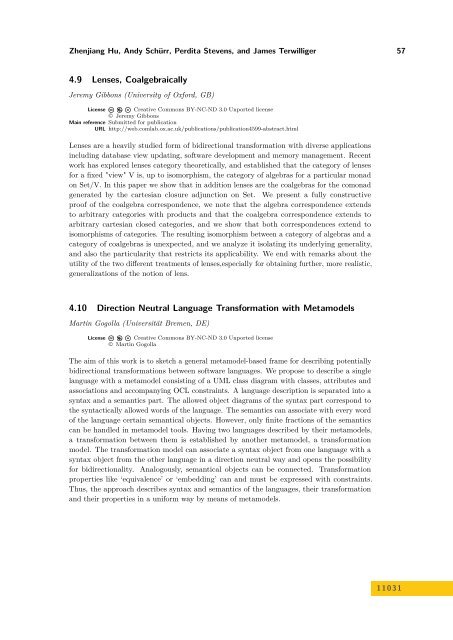Volume 1, Issue 1, January 2011 - DROPS - Schloss Dagstuhl
Volume 1, Issue 1, January 2011 - DROPS - Schloss Dagstuhl
Volume 1, Issue 1, January 2011 - DROPS - Schloss Dagstuhl
You also want an ePaper? Increase the reach of your titles
YUMPU automatically turns print PDFs into web optimized ePapers that Google loves.
Zhenjiang Hu, Andy Schürr, Perdita Stevens, and James Terwilliger 57<br />
4.9 Lenses, Coalgebraically<br />
Jeremy Gibbons (University of Oxford, GB)<br />
License Creative Commons BY-NC-ND 3.0 Unported license<br />
© Jeremy Gibbons<br />
Main reference Submitted for publication<br />
URL http://web.comlab.ox.ac.uk/publications/publication4599-abstract.html<br />
Lenses are a heavily studied form of bidirectional transformation with diverse applications<br />
including database view updating, software development and memory management. Recent<br />
work has explored lenses category theoretically, and established that the category of lenses<br />
for a fixed "view" V is, up to isomorphism, the category of algebras for a particular monad<br />
on Set/V. In this paper we show that in addition lenses are the coalgebras for the comonad<br />
generated by the cartesian closure adjunction on Set. We present a fully constructive<br />
proof of the coalgebra correspondence, we note that the algebra correspondence extends<br />
to arbitrary categories with products and that the coalgebra correspondence extends to<br />
arbitrary cartesian closed categories, and we show that both correspondences extend to<br />
isomorphisms of categories. The resulting isomorphism between a category of algebras and a<br />
category of coalgebras is unexpected, and we analyze it isolating its underlying generality,<br />
and also the particularity that restricts its applicability. We end with remarks about the<br />
utility of the two different treatments of lenses,especially for obtaining further, more realistic,<br />
generalizations of the notion of lens.<br />
4.10 Direction Neutral Language Transformation with Metamodels<br />
Martin Gogolla (Universität Bremen, DE)<br />
License Creative Commons BY-NC-ND 3.0 Unported license<br />
© Martin Gogolla<br />
The aim of this work is to sketch a general metamodel-based frame for describing potentially<br />
bidirectional transformations between software languages. We propose to describe a single<br />
language with a metamodel consisting of a UML class diagram with classes, attributes and<br />
associations and accompanying OCL constraints. A language description is separated into a<br />
syntax and a semantics part. The allowed object diagrams of the syntax part correspond to<br />
the syntactically allowed words of the language. The semantics can associate with every word<br />
of the language certain semantical objects. However, only finite fractions of the semantics<br />
can be handled in metamodel tools. Having two languages described by their metamodels,<br />
a transformation between them is established by another metamodel, a transformation<br />
model. The transformation model can associate a syntax object from one language with a<br />
syntax object from the other language in a direction neutral way and opens the possibility<br />
for bidirectionality. Analogously, semantical objects can be connected. Transformation<br />
properties like ‘equivalence’ or ‘embedding’ can and must be expressed with constraints.<br />
Thus, the approach describes syntax and semantics of the languages, their transformation<br />
and their properties in a uniform way by means of metamodels.<br />
1 1 0 3 1













